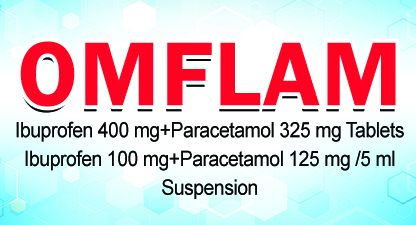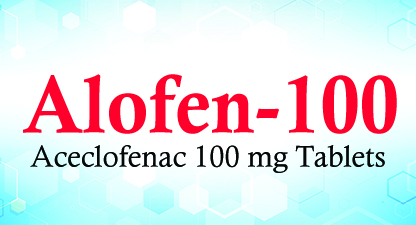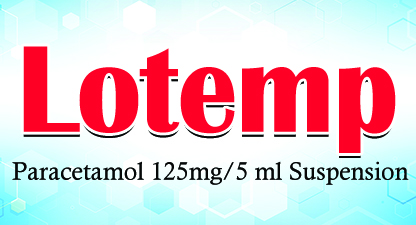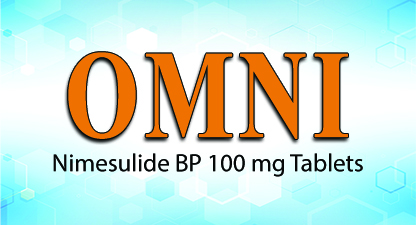OMFLAM
Ibuprofen is a non-steroidal anti-inflammatory medication. It is an effective painkiller and is prescribed in higher doses to relieve inflammation, swelling and stiffness. It is often used to provide pain relief in a wide range of conditions ranging from menstrual and dental pain to post-operative pain. It is effective in reducing fever and is also prescribed for the treatment of arthritic conditions such as rheumatoid- and osteoarthritis, muscle injury, acute attacks of gout.
Paracetamol is the analgesic of choice for mild to moderate pain and is also used to reduce fever. It is suitable for both adults and children and, as it does not cause stomach irritation, it is safe to be used by those who suffer from peptic ulcers and those who cannot take aspirin.
- Categories : NSAIDs
- Share Now :
OMFLAM
Generic Name: Ibuprofen and Paracetamol
Composition: Omflam Tablets
Each uncoated tablet contains Ibuprofen 400 mg and Paracetamol 325 mg
Omflam Suspension
Each 5 ml contains Ibuprofen 100 mg and Paracetamol 125 mg
Pregnancy Category: Not Specified
Presentation: Omflam Tablets
Available in the pack size as 10 tablets X 30 blisters
Omflam Suspension
Available in 60 ml bottle with a measuring cap
Mechanism of Action
The main mechanism of action of ibuprofen is the non-selective, reversible inhibition of the cyclooxygenase enzymes COX-1 and COX-2 enzymes..The mode of action of ibuprofen is thought to mainly arise from the inhibition of synthesis of prostaglandins (PGE2). In addition, ibuprofen scavenges HO. radical, .NO and ONOO - and can potentiate or inhibit nitric oxide formation through its effects on nitric oxide synthase (NOS) isoforms.
Unlike other NSAIDs, paracetamol does not to inhibit the function of any cyclooxygenase (COX) enzyme outside the central nervous system, and this appears to be the reason why it is not useful as an anti-inflammatory. It does appear to selectively inhibit COX activities in the brain, which may contribute to its ability to treat fever and pain.
The combination of ibuprofen and paracetamol, therefore, shows a combined effect in relieving pain and reducing fever and inflammation.
Indications
Pain and inflammation associated with musculoskeletal and joint disorders.
Dosage
Route of administration: Oral
Adult: 1 tablet Omflam 3-4 times daily.
Child: 1 dose of Omflam suspension three times a day or as required.
Adverse Effects
Dyspepsia, heart burn, GI bleeding, rash, asthmatic attacks, thrombocytopenia, drug induced ulcer, drowsiness, hepatic necrosis, renal papillary necrosis, vision disturbances & disorientation; rarely nausea & vomiting can occur.
Contraindications
OMFLAM is contraindicated in the following populations and situations:
- Hypersensitivity to aceclofenac or any other components of the formulation.
- Active or history of peptic ulcer disease, hemorrhage, bleeding disorders.
- Neonates
Precautions
- Pregnancy and breastfeeding
- Bronchial asthma
- Renal or hepatic disorders
- CV diseases, hypertension
- NSAIDs induced allergy.
Interactions
- Furosemide & thiazides: May antagonize their action
- Pethidine & propanthelene: They reduce the absorption of Omflam
- Antihypertensive: Omflam may reduce its effectiveness.






